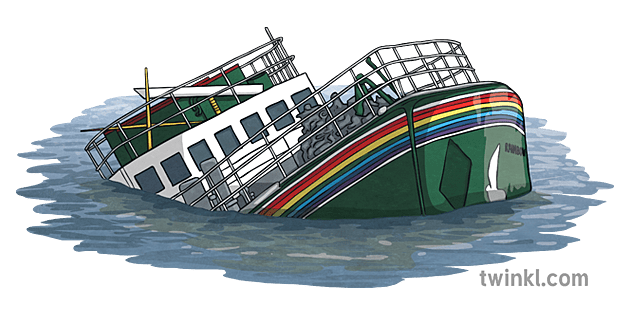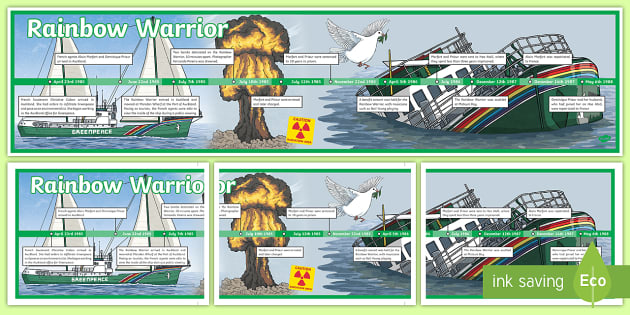

The Rainbow Warrior was the name of a Greenpeace boat that was an active part in supporting a series of Greenpeace campaigns during the 1970s and 1980s. The campaigns it was a part of including anti-whaling, anti-seal hunting, anti-nuclear testing and anti-nuclear waste dumping. Before the Rainbow Warrior was bought by Greenpeace UK, it was a trawler commissioned by the UK Ministry of Agriculture, Fisheries and Food (MAFF).
Greenpeace bought this ship in 1977 and named it the ‘Rainbow Warrior’ after the book titled ‘Warriors of the Rainbow’ which said “The world is sick and dying, the people will rise up like Warriors of the Rainbow”. The Rainbow Warrior was a part of a series of high-profile campaigns in the North Atlantic, following which it made its way to North America in 1981 for more modifications and the fitting of sails.
In 1985, the Rainbow Warrior in the Pacific Ocean campaigning against nuclear testing following which it made its way to New Zealand to lead a fleet of yachts that were part of a protest against French Nuclear Testing at the Mururoa Atoll in the Tuamoto Archipelago of French Polynesia.
For the protests in 1985, the aim of Greenpeace was to monitor the impact of nuclear tests and place protestors on the island to monitor the blasts. Christine Cabon, a DGSE (direction générale de la sécurité extérieure) agent, infiltrated the Auckland office of Greenpeace where she monitored communications that came from the Rainbow Warrior, collected maps and investigated underwater equipment. Other French agents also pretended to be interested supporters and toured the Rainbow Warrior when it was open for the public to view.
The sinking of the Rainbow Warrior was codenamed ‘Opèration Satanique’ and was a bombing operation that was carried out by the “action” branch of the French foreign intelligence services - the DGSE. The bombing was carried out on the 10th of July 1985 at the Port of Auckland, New Zealand by two explosives that were attached to the hull of the boat by the operatives of the DGSE. The ship was bombed in an attempt to stop it from protesting against nuclear testing.
As a result of these explosions, the photographer Fernando Pereira was killed when he went back to the boat to retrieve his equipment after the first explosion. The second, larger explosion resulted in the sinking of the Rainbow Warrior.
The remains of the wreck of the Rainbow Warrior were retrieved in August 1985. However, the damage was too extensive for repair and the vessel was sent to Matauri Bay in Cavalli Islands, New Zealand in December 1987 to serve as a dive wreck and artificial reef in order to promote marine life. The masts of the Rainbow Warrior were recovered and now stand outside the Dargaville Museum.
The bombing of the Rainbow Warrior took place close to midnight, with all crew members on board. Following the first explosion, the crew who were already on deck scrambled up the ladder or leapt to safety on the wharf. This helped save most of their lives. However, the photographer Fernando Pereira was killed when he went back to retrieve his photography equipment after the first explosion by the second explosion that happened 10 minutes later.
Fernando Pereira was a Portuguese photographer that had joined the crew of the Rainbow Warrior to document French nuclear testing for the world. He was caught in a rush of water following the second explosion and drowned.
The involvement of the French was revealed following the arrests of two French agents, and caused a political scandal, resulting in the French Minister of Defence - Charles Hernu, resigning. The French agents that were captured were imprisoned followed which they were transferred to French custody where they were confined to a French military based on the Island of Hao before being released.
Following international pressure, the government of France agreed to compensate Greenpeace. In September 1985, the French Prime Minister, Laurent Fabius, acknowledged that there had been a cover-up and stated that the “Agents of the French secret service sank this boat. They were acting on orders.”
The sinking of the Rainbow Warrior led at Greenpeace and the French Republic entering an agreement to submit Greenpeace’s claims against France to international arbitration. The result of this arbitration ordered France to pay US $8.1 million to Greenpeace. This victory was described by the chairman of Greenpeace as “a great victory for those who support the right of peaceful protest and abhor the use of violence.”.
One of the major consequences of the bombing of the Rainbow Warrior was the direct and severe effect it had on New Zealand’s relationship with France. The then Prime Minister of New Zealand, David Lange, expressed his discontentment with the French Prime Minister Laurent Fabius for not naming the French agents involved and exonerating them from blame. Trade between the two countries started to slow down as both countries began to boycott imports from the other country.
This issue was finally settled by the United Nations when the UN Secretary-General, Javier Perez de Cuellar announced on the 8th of July 1986 that France would issue an apology to New Zealand and give them a compensation of NZ $13 million. Additionally, France was also banned from interfering in New Zealand trade negotiations.
The bombing of the Rainbow Warrior is an important part of New Zealand’s history. It still continues to be referred to in the media and in current events. Additionally, it is an important milestone in New Zealand’s anti-nuclear movement. The bombing of the Rainbow Warrior put a spotlight on New Zealand’s anti-nuclear movement, both locally and internationally, and helped the movement gain support.
The Rainbow Warrior is still an important part of the anti-nuclear movement even today. Greenpeace continued the legacy of the Rainbow Warrior by building a second Rainbow Warrior which is still used to protest against French nuclear testing and a third Rainbow Warrior which is used to protest other issues that are of importance to Green Peace.
The sinking of the Rainbow Warrior is an important part of New Zealand’s history, and is a milestone for New Zealand’s anti-nuclear movement. This makes it an important event for all students in New Zealand to learn about. Learning about the sinking of the Rainbow Warrior is also an interesting way to teach your students about the history of the relationship between New Zealand and France.
Teaching your NZ students about the Rainbow Warrior is also a great way to start a discussion with your class about the event of the bombing of the Rainbow Warrior, and also about nuclear testing and why some people are against it.
We have loads of fun and exciting resources that you can use to get your NZ students involved and enthusiastic to learn about the Rainbow Warrior
The Rainbow Warrior Display Timeline is a visual timeline that you can use to help your students learn about the events that occurred when the Rainbow Warrior was bombed. This beautifully illustrated visual timeline would make a great addition to your classroom display. You can print out this timeline over 3 x A4 sheets of paper. This timeline includes an illustration of the Rainbow Warrior with labels of what happened when it was bombed.
The Rainbow Warrior Fact File is a neat resource that you can use to teach your students about what happened when the Rainbow Warrior was bombed. This fact file includes key information including when it happened, where it happened, and what happened. It also comes with a list of interesting facts about the Rainbow Warrior and the bombing that your students are sure to enjoy.
The Rainbow Warrior Fact Cards is a collection of fact cards that each contain facts about the bombing of the Rainbow Warrior. You can use these fact cards with your NZ students to start a discussion about the events that happened and to encourage them to learn more about the Rainbow Warrior. As a fun activity, you could jumble up the fact cards and encourage your students to arrange the cards in order of the events that happened as a way to test their knowledge.
The Rainbow Warrior Display Banner is a great resource to use as part of your classroom display. This beautifully illustrated display banner prints over 3 x A4 sheets of paper and would make a great heading to a display about the Rainbow Warrior. You can encourage your students to bring their own photographs, drawings and writing activities to add to this beautiful display.
 Home
Home  Membership
Membership  Customer Support
Customer Support  Create
Create  Blog
Blog 























